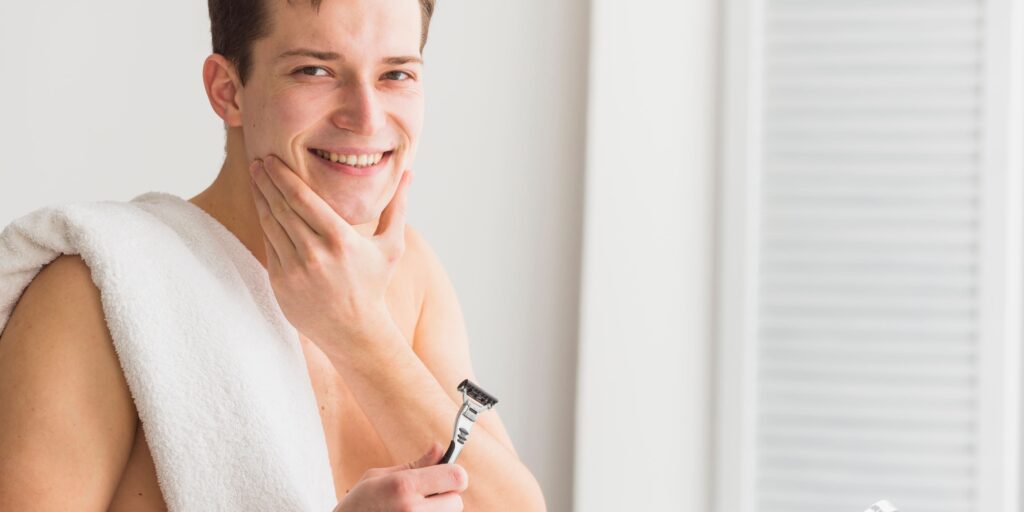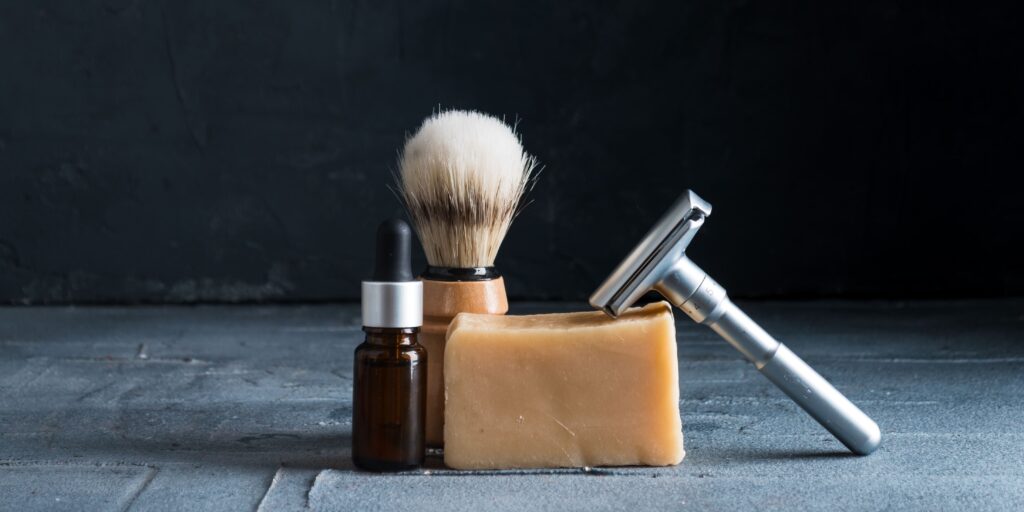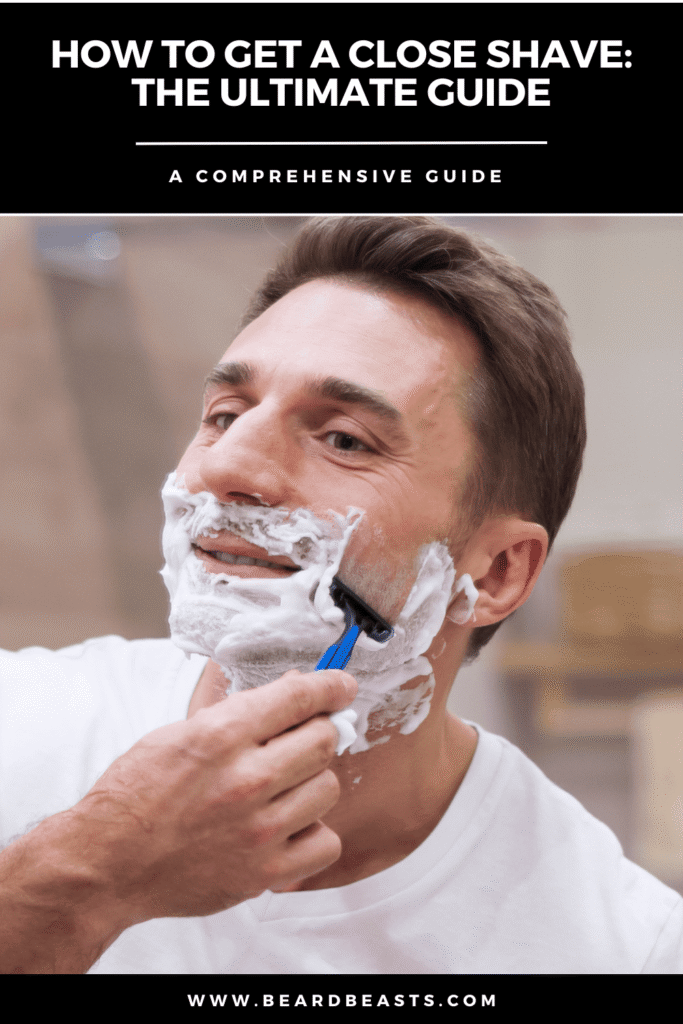Learning how to get a close shave can transform your daily grooming routine, leaving your skin smooth and irritation-free. In this comprehensive guide, we’ll walk you through the essential steps for preparing your skin, choosing the right tools, mastering shaving techniques, and perfecting post-shave care.
Whether you’re a beginner or a seasoned shaver, our tips will help you avoid common mistakes, address shaving problems, and achieve the closest shave possible.
Let’s dive into the art of shaving and discover how you can enjoy a flawless, comfortable shave every time.
Preparing Your Skin for a Close Shave
Achieving a smooth, close shave starts with proper skin preparation. Follow these steps before learning how to get a close shave to ensure your face is ready for the best shave ever!

Cleanse Your Face
Importance of Starting with a Clean Face
Before you even think about picking up that razor, make sure your face is clean. A clean face removes dirt, oil, and impurities that can clog your razor and cause irritation.
Recommended Facial Cleansers
- Neutrogena Oil-Free Acne Wash: Perfect for those prone to breakouts.
- CeraVe Hydrating Facial Cleanser: Ideal for dry skin.
Exfoliation
Benefits of Exfoliating Before Shaving
Exfoliating removes dead skin cells that can block your razor and cause uneven shaving. It helps to lift hairs, making it easier for your razor to cut them close to the skin.
Best Exfoliating Products or Techniques
- Scrubs: Look for gentle facial scrubs with fine grains.
- St. Ives Fresh Skin Apricot Scrub
- Kiehl’s Facial Fuel Energizing Scrub
Hydration
Why Hydrating Your Skin is Crucial
Hydrating your skin softens hair follicles, making them easier to cut. It also reduces the risk of cuts and irritation.
Use of Warm Water or Pre-Shave Oil
- Warm Water: Splash your face with warm water or use a warm towel for a few minutes. This opens up your pores and softens the hair.
- Pre-Shave Oil: Apply a few drops of pre-shave oil to lock in moisture and provide a smooth surface for your razor.
- Art of Shaving Pre-Shave Oil
- Jack Black Beard Lube Conditioning Shave
By following these steps, you’re setting yourself up for a close, comfortable shave every time. Remember, preparation is key to getting a close shave without irritation!
Choosing the Right Tools
The right tools make all the difference when it comes to how to get a close shave. Let’s dive into the essentials you’ll need for that perfect shave.

Razors
Types of Razors
Choosing the right razor is crucial. Here are the main types:
- Safety Razor: Ideal for a traditional, close shave. It’s less likely to cause irritation but requires some practice.
- Cartridge Razor: Common and convenient, perfect for beginners. Multiple blades provide a close shave but can cause irritation if not used properly.
- Straight Razor: Offers the closest shave but requires skill and patience. Best for experienced shavers.
How to Choose the Best Razor for Your Skin Type
- Sensitive Skin: Go for a safety razor or a cartridge razor with fewer blades.
- Thick Hair: A straight razor or a high-quality cartridge razor will work best.
- Normal Skin: Most razors will suit you, but consider your comfort and shaving preferences.
Shaving Creams and Soaps
Difference Between Creams, Soaps, and Foams
- Creams: Easy to lather, providing a smooth and moisturizing shave. Great for all skin types.
- Soaps: Offer a rich lather and are long-lasting. Perfect for those who enjoy the traditional shaving experience.
- Foams: Convenient and quick but can be drying. Suitable for quick shaves and less sensitive skin.
Our Recommendations
- Tea Tree Triple Butter Shaving Soap: This soap is perfect for moisturizing and soothing the skin. Its tea tree oil helps prevent irritation.
- Black Salt Shaving Soap: Known for its detoxifying properties, this soap provides a luxurious lather and a close shave.
Brushes
Benefits of Using a Shaving Brush
- Better Lather: A brush helps to create a rich, thick lather, ensuring a smoother shave.
- Exfoliation: It gently exfoliates your skin, removing dead skin cells and lifting hairs.
- Even Application: Distributes shaving cream or soap evenly across your face.
How to Properly Use a Shaving Brush
- Soak the Brush: Wet your shaving brush with warm water for a few minutes.
- Load the Brush: Swirl it in your shaving cream or soap to load it up.
- Lather Up: In circular motions, apply the lather to your face. This softens the hairs and prepares your skin for shaving.
By selecting the right tools, you’re one step closer to mastering how to get a close shave.
How To Get A Close Shave: Best Shaving Techniques
Mastering the right techniques is crucial for achieving that smooth, close shave. Let’s explore the best methods to get you there.

Shave with the Grain
Explanation of Shaving with the Grain
Shaving with the grain means shaving in the direction your hair grows. It’s usually downwards on your cheeks and upwards on your neck, but it can vary.
Benefits and Why It’s Essential
- Reduces Irritation: Shaving with the grain minimizes tugging and pulling, which reduces skin irritation.
- Prevents Razor Burn: Following the hair growth direction helps prevent razor burn and ingrown hairs.
- Easier on Your Skin: It’s a gentler approach, making it perfect for those with sensitive skin.
Use Short, Light Strokes
Technique Tips for Reducing Irritation and Achieving a Close Shave
- Short Strokes: Use short, controlled strokes rather than long, sweeping ones. This gives you more precision and reduces the risk of nicks.
- Light Pressure: Apply just enough pressure to let the razor glide over your skin. Too much pressure can lead to cuts and irritation.
- Rinse Often: Rinse your razor frequently to keep it clean and prevent clogging.
Re-lather and Shave Across the Grain (if necessary)
When and Why to Shave Across the Grain
Once you’ve completed a pass with the grain, re-lather your face. Shaving across the grain (at a perpendicular angle to hair growth) can help you get an even closer shave, but it’s not always necessary.
Steps to Ensure Minimal Irritation
- Re-lather: Apply a fresh layer of shaving cream or soap to provide a protective cushion.
- Shave Across the Grain: Gently shave across the grain. Avoid going against the grain as it can cause irritation and ingrown hairs.
- Use Light Strokes: Continue to use short, light strokes to maintain control and reduce the risk of irritation.
By mastering these techniques, you’re well on your way to understanding how to get a close shave. Enjoy the process and the smooth results!
Post-Shave Care
Taking care of your skin after shaving is just as important as the shave itself. Proper post-shave care ensures your skin stays smooth, hydrated, and irritation-free.
Rinse with Cold Water
Benefits of Using Cold Water Post-Shave
- Closes Pores: Cold water helps to close your pores, reducing the risk of bacteria entering and causing irritation or breakouts.
- Reduces Inflammation: It helps calm the skin and reduces redness and swelling.
- Refreshing Feel: Gives a refreshing and invigorating finish to your shave.
Apply Aftershave Balm
Why Use an Aftershave Balm?
Applying an aftershave balm is crucial for soothing your skin and preventing irritation.
- Hydration: Our Dream Aftershave Balm deeply hydrates your skin, keeping it calm and conditioned throughout the day.
- Protection: This deluxe aftershave for men safeguards against irritation and razor burn.
- Ingredients: Packed with nourishing ingredients to soothe and protect your skin.
Moisturize
Importance of Moisturizing After Shaving
- Replenishes Moisture: Shaving can strip your skin of natural oils. Moisturizing helps to replenish this lost moisture.
- Promotes Healing: It aids in the healing process, especially if you’ve nicked or irritated your skin.
- Maintains Smoothness: Keeps your skin soft and smooth, enhancing the overall feel of your shave.
Recommended Moisturizers for Post-Shave Care
- Neutrogena Hydro Boost Gel-Cream: Lightweight, non-greasy, and intensely hydrating.
- Kiehl’s Ultra Facial Cream: Perfect for all skin types, offering 24-hour hydration.
By following these post-shave care tips, you’ll ensure your skin remains healthy and smooth, solidifying your mastery of how to get a close shave.
Common Shaving Mistakes to Avoid
Even seasoned shavers can fall into bad habits. Avoid these common mistakes to perfect how to get a close shave and keep your skin happy and healthy.
Using a Dull Blade
Risks of Shaving with a Dull Blade
- Irritation: A dull blade drags on the skin, causing irritation and redness.
- Nicks and Cuts: Increases the chance of cutting yourself as you apply more pressure.
- Ineffective Shaving: Results in a less close shave, requiring multiple passes over the same area.
How Often to Change Your Razor Blades
- Safety Razors: Change the blade after 5-7 shaves.
- Cartridge Razors: Replace the cartridge after 3-5 uses.
- Straight Razors: Sharpen regularly and replace if the edge becomes damaged.
Pressing Too Hard
Why Light Pressure is Crucial
- Prevents Cuts: Light pressure minimizes the risk of nicks and cuts.
- Reduces Irritation: Gentle pressure reduces the friction on your skin, preventing razor burn and redness.
Techniques to Avoid Pressing Too Hard
- Let the Razor Glide: Allow the razor’s weight to do the work. Hold it lightly and let it glide over your skin.
- Use Short Strokes: Short, controlled strokes give you better control and reduce the need to press hard.
- Keep the Blade Sharp: A sharp blade cuts more efficiently, requiring less pressure.
Skipping Pre-shave Preparation
Consequences of Not Preparing Your Skin
- Increased Irritation: Dry shaving or skipping prep can cause serious irritation.
- Poor Shave Quality: Without proper preparation, you won’t achieve a close shave, leading to stubble and uneven areas.
- Higher Risk of Ingrown Hairs: Lack of prep can result in hairs being cut at awkward angles, increasing the chance of ingrown beard hairs.
Quick Tips for Efficient Pre-shave Preparation
- Cleanse: Wash your face with warm water and a gentle cleanser to remove dirt and oil.
- Exfoliate: Use a mild exfoliator to remove dead skin cells and lift hairs.
- Hydrate: Wet your face with warm water or use a pre-shave oil to soften hairs and skin.
By steering clear of these common shaving mistakes, you’ll be well on your way to mastering how to get a close shave every time.
Addressing Shaving Problems
Even with the best techniques, shaving problems can still occur. Let’s look at common issues like razor burn, ingrown hairs, and solutions for sensitive skin. Understanding these can enhance your shaving routine and ensure you know how to get a close shave without hassle.
Razor Burn
Causes and Prevention Strategies
- Causes: Razor burn can result from using a dull blade, applying too much pressure, or shaving too quickly.
- Prevention:
- Use a Sharp Blade: Always shave with a sharp, clean blade.
- Prep Properly: Cleanse, exfoliate, and hydrate your skin before shaving.
- Shave with the Grain: Follow the direction of hair growth.
- Use a Good Lubricant: Shaving creams or gels help the razor glide smoothly.
Treatment Options if You Get Razor Burn
- Cold Compress: Apply a cold, damp cloth to soothe irritation.
- Aloe Vera Gel: Use aloe vera gel to reduce redness and inflammation.
- Aftershave Balm: Apply a soothing aftershave balm to calm your skin.
Ingrown Hairs
Why They Occur and How to Prevent Them
- Causes: Ingrown hairs happen when shaved hairs grow back into the skin, often due to curly hair, shaving too close, or improper technique.
- Prevention:
- Exfoliate Regularly: Keep your skin free of dead skin cells.
- Don’t Shave Too Close: Avoid shaving against the grain and pressing too hard.
- Use a Sharp Razor: A sharp blade cuts hair cleanly, reducing the chance of ingrown hairs.
Remedies for Ingrown Hairs
- Warm Compress: Apply a warm compress to soften the skin and help the hair emerge.
- Exfoliate: Gently exfoliate the area to remove dead skin cells and free the trapped hair.
- Topical Treatments: Use products containing salicylic acid or tea tree oil to reduce inflammation.
Sensitive Skin Solutions
Tips for Those with Sensitive Skin
- Patch Test Products: Test new shaving products on a small skin area to check for reactions.
- Use Hypoallergenic Products: Opt for products labeled as hypoallergenic to minimize irritation.
- Shave Less Frequently: Give your skin time to recover between shaves.
Recommended Products for Sensitive Skin
- Shaving Creams: Look for fragrance-free options.
- Cremo Cooling Shave Cream
- Aveeno Therapeutic Shave Gel
- Aftershave Balms: Choose soothing and hydrating formulas.
- Beard Beasts Post Shave Dream Aftershave Balm
By addressing these common shaving problems, you’ll be well-equipped to know how to get a close shave without the discomfort.
Frequently Asked Questions
Got questions about how to get a close shave? You’re not alone! Here are some common questions and answers to help you achieve the perfect shave every time.
How Do You Get a Really Close Shave?
Achieving a really close shave involves a few key steps:
- Prepare Your Skin: Cleanse, exfoliate, and hydrate your skin before shaving.
- Use the Right Tools: Choose a sharp razor, quality shaving cream or soap, and a good shaving brush.
- Shave with Proper Technique: Shave with the grain using short, light strokes, and re-lather if you shave across the grain.
- Post-Shave Care: Rinse with cold water, apply aftershave balm, and moisturize your skin.
Why Can’t I Get a Close Shave?
There are several reasons you might not be getting a close shave:
- Dull Blade: A dull razor blade can’t cut hair effectively.
- Incorrect Technique: Pressing too hard or shaving against the grain can cause issues.
- Insufficient Prep: Not properly cleansing, exfoliating, or hydrating your skin.
- Skin Condition: If you have sensitive or acne-prone skin, it might affect the closeness of your shave.
What Gives the Closest Shave?
For the closest shave, consider the following:
- Straight Razor: Known for providing the closest shave, but requires skill and practice.
- Safety Razor: Offers a close shave with less irritation if used correctly.
- Proper Shaving Products: Using a high-quality shaving cream or soap and a shaving brush helps lift and soften hairs for a closer cut.
Is It Better to Shave Up or Down?
The direction you shave can impact the closeness and comfort of your shave:
- Shaving Down (With the Grain):
- Pros: Reduces irritation and minimizes the risk of cuts.
- Cons: Might not provide the closest shave on its own.
- Shaving Up (Against the Grain):
- Pros: Can result in a closer shave.
- Cons: Increases the risk of irritation and ingrown hairs.
Best Approach: Start by shaving with the grain. If needed, re-lather and shave across the grain for a closer finish. Avoid shaving directly against the grain to minimize irritation.
By understanding these frequently asked questions, you’ll be well on your way to mastering how to get a close shave.

Conclusion
Achieving the perfect shave might seem like a daunting task, but with the right preparation, tools, and techniques, it’s entirely within your reach. Here’s a quick recap to keep in mind:
- Prepare Your Skin: Cleanse, exfoliate, and hydrate to set the stage for a smooth shave.
- Choose the Right Tools: Select a suitable razor, quality shaving cream or soap, and a good shaving brush.
- Master the Technique: Shave with the grain using short, light strokes, and re-lather if necessary.
- Post-Shave Care: Rinse with cold water, apply a soothing aftershave balm, and moisturize your skin.
- Avoid Common Mistakes: Change your razor blades regularly, avoid pressing too hard, and always prep your skin properly.
- Address Shaving Problems: Use targeted solutions for razor burn, ingrown hairs, and sensitive skin.
By following these tips and avoiding common pitfalls, you’ll not only learn how to get a close shave but also enjoy a smoother, more comfortable shaving experience. Remember, shaving is as much about the journey as it is about the destination. Take your time, enjoy the process, and your skin will thank you.





